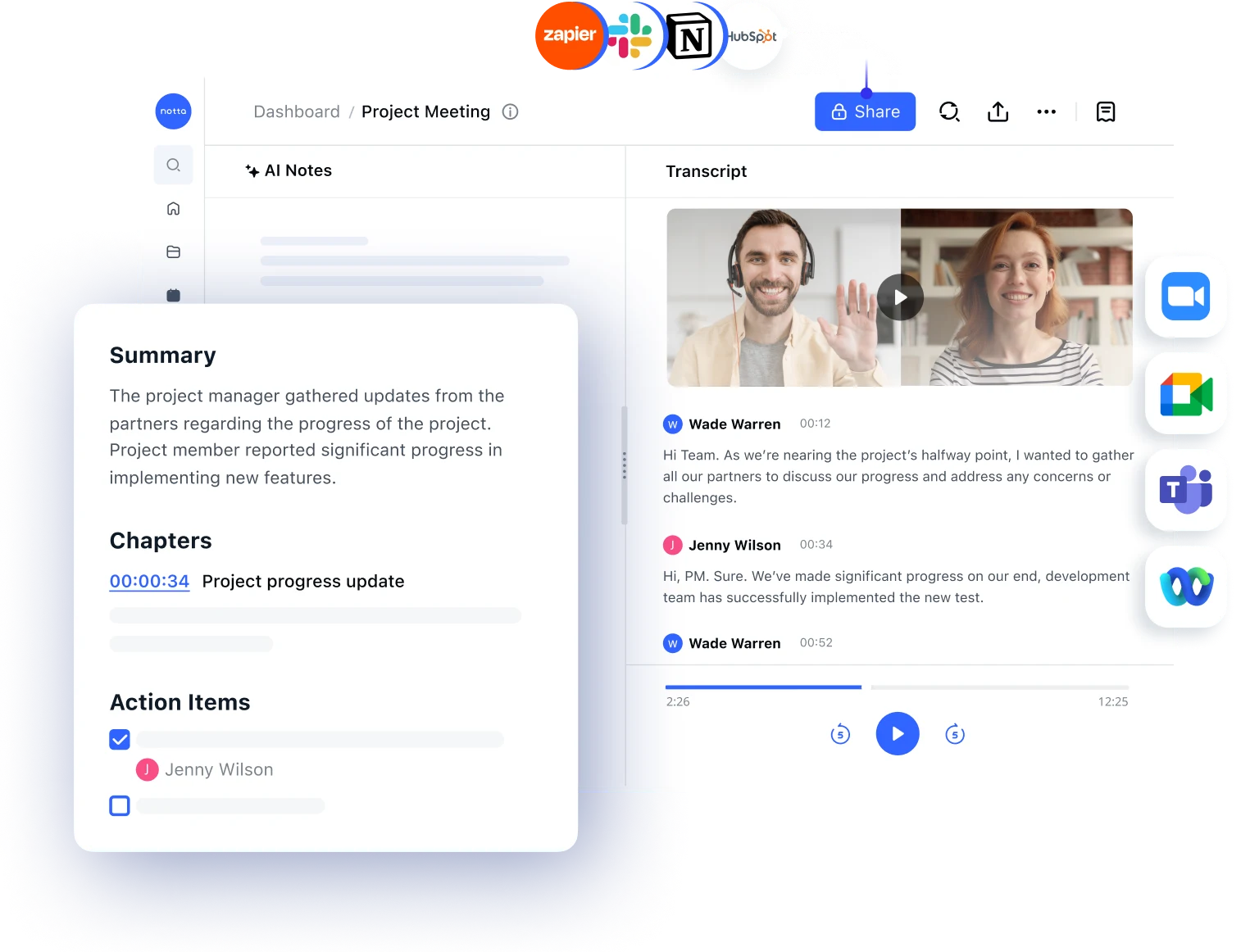If you’ve been a part of meetings in the past, chances are you’ve come across the terms ‘meeting minutes’ or ‘meeting notes,’ and while the two might seem like the same thing, they are, in fact, different. What are these differences, you may ask, and should you be taking minutes or notes during a meeting?
Over the years, I’ve seen several people use these terms interchangeably, which often leads to a host of issues later on. So, to help clarify the differences between the two, I’ll explain the meeting notes vs minutes in detail, along with certain best practices you must follow when recording them.
I’ll also offer a template for each type of documentation you can use to get started the next time you get your team together.
Choose between meeting notes and meeting minutes
If your aim is to capture the gist of a meeting and the key action points discussed at a rather informal level, you can record meeting notes.
On the other hand, if you need to document everything discussed for future reference and for the purpose of compliance, it’s crucial that you record the meeting minutes.
Here is a quick comparison of meeting notes vs minutes.
| Factor | Meeting Notes | Meeting Minutes |
| Formality | Notes are typically informal and meant for teams to use internally. | Minutes are a formal document relied on for financial, legal, and compliance-related issues. |
| Content | Notes account for key points, action items, decisions, and the date. | Minutes record discussions in detail, decisions made, votes, the meeting’s outcome, and any formal action taken. |
| Use cases | Their informal nature comes from their reliance during team discussions or huddles as an information aid. | Minutes are used during AGMs, board meetings, legal proceedings and to ensure compliance with regulations. |
| Distribution | Notes are typically shared among those attending the meeting and anyone involved with the project at hand. | Minutes are distributed to select stakeholders as they often contain sensitive and confidential information. |
| Effort | Notes require low effort as they’re not formal or need not follow a specific structure. | Documenting minutes can be time-consuming as they must be comprehensive, structured, and formal in their tone. |
What are meeting notes?
Title of the meeting
Date: (the date the meeting was held)
Participants:
Participant 1
Participant 2
Participant 3
Goals:
Discussion topics:
Discussion topic 1:
Key point discussed 1
Key point discussed 2
Discussion topic 2:
Key point discussed 1
Key point discussed 2
Action items:
Action item 1
Action item 2
Decisions:
Put simply, meeting notes are a record of what was discussed over the course of a meeting. They aren’t usually chronological and are generally based on the meeting’s theme. As a result, they’re also less formal and are primarily used to capture the action points discussed.
One of the key factors that distinguish meeting notes from minutes is that they’re typically used as a memory aid for those who attend rather than serving a legal or financial purpose in an official capacity.
What’s more, meeting notes can often be documented by more than one person and shared among those who aren’t present. As a result, they must be objective and factual as opposed to personal, thereby ensuring those not in attendance can extract value from them later.
Effortlessly create meeting notes
With Notta, you can easily generate meeting notes, turning spoken content into written records with 98.86% accuracy. Stay organized and capture every key detail in your meetings.
What are meeting minutes?
Title of the meeting
Location: (where the meeting was held)
Date: (the date the meeting was held)
Time: (the specific time the meeting was held)
Attendance:
Name of participant 1 - (mark if absent)
Name of participant 2 - (mark if absent)
Name of participant 3 - (mark if absent)
Agenda:
Agenda item 1
Key point discussed 1
Key point discussed 2
Agenda item 2
Key point discussed 1
Key point discussed 2
Agenda item 3
Key point discussed 1
Key point discussed 2
Next steps:
Action item 1
Action item 2
Action item 3
Announcements:
Adjournment:
(the time the meeting was adjourned)
Unlike meeting notes, meeting minutes are more formal documentation of everything discussed during a meeting and are a legal document that offers insights on action items, decisions, or votes. Whether they’re corporate meeting minutes or those for financial or legal meetings, they’re always formal in their structure.
But how detailed should meeting minutes be? Because of their formality, minutes are often relied upon to ensure compliance and are driven by an agenda that’s set and distributed before a meeting begins. They’re also used during legal cases and must thus offer an objective and transparent overview of everything discussed and decided during a meeting.
They’re also structured when compared to meeting notes, with the list of attendees mentioned, each item on the agenda along with a brief description, and their respective outcomes, among other key details.
Importantly, unlike meeting notes, which can be recorded or written by multiple individuals, minutes are recorded by a designated minute-taker or by using note-taking software.
Best practices for taking meeting notes and minutes
Whether you decide to take meeting notes or minutes, there are certain best practices you must follow to ensure they prove helpful and effective. I discuss a few of these below.
Record clear and concise notes: Regardless of whether you take minutes or notes, the content must be clearly and concisely recorded. This ensures that any discussions, action items, or decisions made are clear. An AI note-taking tool like Notta can be ideal for ensuring notes are accurately documented.

Rely on standardized templates: Using a standard template to record meetings or notes can help save time and make your documentation efficient.
Ensure confidentiality: Meetings often lead to discussions on topics that are sensitive or confidential. Ensuring that your notes or minutes are secure helps ensure privacy and prevent data breaches.
Actively listen: Note-taking can only be effective when you practice active listening, as it ensures the information is documented comprehensively. Using meeting management software can ensure every detail is captured with the highest possible accuracy.
Use note-taking tools: AI-powered note-taking tools can streamline the process of note-taking with automated recording and summarizing. Notta is one such tool that can be used to document your meetings comprehensively and save you time and energy.
Divide responsibilities: For meetings with clearly defined agendas, it can be helpful to divide the note-taking process among multiple individuals to ensure no single person is burdened with the whole process from start to finish.
Key takeaways
Meeting notes and minutes are both incredibly effective tools for documenting every aspect of a meeting, from the key points to the action items and decisions. However, both are different in a few unique ways and serve different purposes in an organization.
In this guide, I’ve given you a thorough comparison of meeting notes vs. minutes, provided templates for both, and offered a few best practices you must follow to make your documentation accurate and comprehensive.
If you want to make your note-taking and documentation process a lot more effective, check out Notta. Notta is an AI note-taking tool that streamlines the process of recording and transcribing meeting minutes. It records them with 98.86% accuracy and can also translate them into 50+ languages, making it the ideal tool for teams with diverse linguistic backgrounds.
FAQs
Are meeting notes more informal than meeting minutes?
Yes, meeting notes are more informal than meeting minutes. They serve the role of a team aid or help provide future reference. Minutes, on the other hand, are formal and serve as an official company document for legal and financial purposes. They can also help ensure compliance with key regulations.
Why are meeting notes called minutes?
The word ‘minute’ originates from the Latin word ‘minuta scriptura.’ It directly translates to ‘small notes,’ which condense and summarize the entirety of a meeting’s discussion. This is why meeting notes are often called minutes.
Which is better: meeting notes or minutes?
Meeting minutes are a formal approach to documenting meetings and action items and can be relied on legally, whereas meeting notes are used primarily as a team aid. Which you prefer ultimately depends on the type of meeting you’re organizing and your team’s overall preference.

